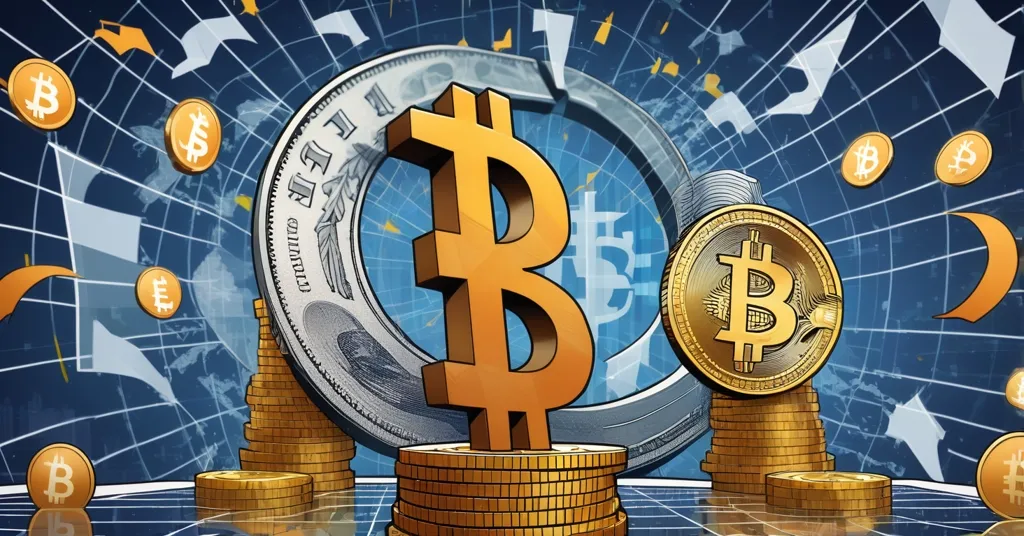ECB’s Lagarde Targets Stronger Euro: Impact on Bitcoin and Stablecoins Unveiled

ECB’s Lagarde Pushes for Stronger Euro: What It Means for Bitcoin and Stablecoins
European Central Bank (ECB) President Christine Lagarde dropped a bombshell in Paris, calling on European governments to beef up the euro’s global clout as doubts swirl around the U.S. dollar under Donald Trump’s polarizing policies. With the dollar’s dominance under scrutiny, Lagarde spies a rare chance to elevate the euro—but can Europe overcome its own economic messes, and what does this mean for Bitcoin and the crypto revolution?
- Euro Ambition: Lagarde sees a “global euro moment” to challenge the dollar amid Trump-era uncertainties.
- Economic Mess: Fragmented rules, high costs, and weak markets hobble the euro zone’s potential.
- Crypto Ripple: A stronger euro could shake stablecoins and Bitcoin’s appeal as a fiat alternative.
Lagarde’s Big Bet on the Euro
The euro, shared by 20 nations in the euro zone, has always lagged behind the U.S. dollar as the world’s go-to currency. But with Trump’s return to the spotlight—think trade wars, hefty tariffs, and isolationist vibes shaking global trust in the dollar—Lagarde senses a shift. She’s dubbed this the “global euro moment,” a strategic opening for the euro to step up as a serious player in international finance. Speaking in Paris, she didn’t mince words: Europe needs to seize this chance or risk staying a perpetual underdog, as highlighted in recent discussions on promoting the euro amidst dollar concerns under Trump’s policies.
“If we strengthen the foundations of the euro now, we can transform our openness into resilience, and our weaknesses into strengths.” – Christine Lagarde
But let’s not pop the champagne just yet. The euro zone is a hot mess of vulnerabilities. When global chaos—like wars or market crashes—drives money into the region as a safer bet, the euro’s value spikes. That sounds great until you realize it screws over exporters. A pricier euro means German cars or French wines cost more abroad, tanking competitiveness. This currency appreciation is just the tip of the iceberg. Lagarde laid bare deeper issues: a patchwork of national regulations, clashing tax systems, inconsistent bankruptcy laws, and energy bills so steep even Bitcoin miners might hesitate to set up shop. Europe’s policy machine moves slower than a congested blockchain transaction—painful to watch.
Euro Zone vs. U.S.: A Financial David and Goliath
Here’s a reality check on scale. The euro zone’s top-tier government bonds are worth €6.6 trillion ($7.7 trillion), a measly fraction of the U.S. Treasury market. European stock markets? They’re less than half the size of their American rivals and nowhere near as slick at funneling cash to where it’s needed. This isn’t just about bragging rights—it’s about raw financial muscle. The U.S. dollar thrives on market depth, meaning its sheer size and ease of trading make it the default for big players globally. Europe, by contrast, is playing catch-up with one hand tied behind its back.
Productivity in the euro zone lags, and high energy costs—worsened by geopolitical messes like the Ukraine crisis—drain competitiveness. Then there’s the political inertia. Harmonizing rules across member states is like herding cats; everyone’s got their own agenda. Collective funding for big projects? Forget it when national interests clash. Lagarde isn’t asking for a quick fix—she’s demanding a full-on overhaul. Without it, this “global euro moment” could fizzle faster than a hyped altcoin.
Unlocking Europe’s Savings: A Crypto Opportunity?
Enter the European Commission’s latest brainchild: the Savings and Investments Union, a rebranded take on the stalled Capital Markets Union. The pitch is simple but staggering—Europeans are sitting on 33 trillion euros in savings, mostly stashed in low-risk cash or bank deposits. Compare that to the U.S., where folks are more likely to pour money into stocks or ventures, fueling growth. This risk-averse streak keeps Europe’s markets sluggish. The new initiative wants to change that with financial education campaigns to demystify investing and tax breaks to sweeten the deal.
But here’s the rub: national governments guard their tax powers like dragons hoarding gold. Many fear these reforms will just pile on more bureaucratic nonsense rather than streamline anything. Still, if even a sliver of that 33 trillion euros gets unleashed, could some flow into crypto? Imagine financial education including a crash course on decentralized finance (DeFi)—suddenly, Bitcoin and altcoins might find new fans. Yet, given Europe’s track record with heavy-handed rules like the Markets in Crypto-Assets Regulation (MiCA), don’t bet on a red carpet for blockchain innovation anytime soon.
Trump’s Shadow: Dollar Woes and Bitcoin’s Rise
Let’s zoom out to why this “global euro moment” exists. Trump’s policies have long rattled faith in the dollar. His trade wars, like slapping tariffs on Chinese goods or bullying allies over NATO funding, sparked fears of dollar weaponization in global politics. During the 2020 election chaos, Bitcoin’s price surged as a hedge against fiat uncertainty—CoinGecko data showed BTC spiking over 20% that November. If Trump’s return brings more of the same, the dollar’s grip could weaken further, giving the euro—and potentially Bitcoin—room to breathe.
Here’s where crypto comes front and center. Stablecoins like USDT and USDC, pegged to the dollar, dominate DeFi and trading. They’re digital currencies designed to hold steady value by mirroring the greenback, underpinning billions in transactions on blockchains like Ethereum. If the dollar stumbles and the euro gains ground, could euro-pegged stablecoins like EURT steal market share? It’s possible, especially if Europe’s financial clout grows. But a stronger euro might also dent Bitcoin’s allure as the ultimate anti-fiat play. Why escape to BTC if the euro becomes a rock-solid reserve? On the flip side, if Europe botches this chance with more red tape, frustrated citizens might flock to decentralized alternatives anyway.
Bitcoin as the True Safe Haven?
Let’s play devil’s advocate. A beefier euro sounds nice for Lagarde, but what if it backfires? If Europe can’t unify its financial house—still squabbling over taxes and rules—trust in the euro might not budge. That’s where Bitcoin shines. Unlike fiat, it’s not beholden to any central bank or bickering government. During past dollar volatility, like the U.S. debt ceiling debacles, Chainalysis noted spikes in crypto adoption as people sought non-sovereign stores of value. If the euro zone stumbles, could BTC become Europe’s unofficial reserve currency by default?
Then there’s the regulatory angle. The euro zone’s fragmented mess has already slowed blockchain adoption compared to the U.S. or Asia. MiCA, while aiming for clarity, risks overregulating startups out of existence. A stronger euro won’t fix that overnight. In fact, if Europe doubles down on control to “protect” its currency, it might push innovators and HODLers straight into Bitcoin’s arms. Talk about an own goal.
Europe’s Blockchain Blind Spots
Speaking of innovation, Europe’s financial lag isn’t just a fiat problem—it’s a blockchain one too. Smaller markets mean less institutional cash for crypto startups. While the U.S. sees venture capital pouring into layer-2 solutions and DeFi protocols, Europe’s risk-averse culture and disjointed policies keep investors on the sidelines. The Savings and Investments Union could help—if it nudges even 1% of that 33 trillion euros toward high-growth assets like crypto. But without clear, unified rules, blockchain projects might keep migrating to friendlier shores.
High energy costs don’t help either. Mining Bitcoin or running Ethereum nodes isn’t cheap when electricity bills rival a small country’s GDP. Miners already flocked to places like Texas after China’s 2021 crackdown—Europe’s not even on their radar. If Lagarde wants a resilient economy, she might need to peek at how crypto’s decentralized ethos could bypass some of these old-world problems. Wishful thinking? Probably.
Key Takeaways and Questions
- What’s Lagarde’s “global euro moment” and its link to Bitcoin?
It’s a window to boost the euro’s global role amid U.S. dollar doubts under Trump’s policies, potentially challenging Bitcoin’s narrative as a fiat hedge if the euro stabilizes. - How do euro zone weaknesses affect crypto adoption?
Fragmented regulations and high costs slow economic growth, limiting funding for blockchain projects and delaying clear crypto frameworks compared to unified markets like the U.S. - Could the Savings and Investments Union boost decentralized finance?
Unlocking 33 trillion euros in savings might channel funds into DeFi if education and policies align, though Europe’s regulatory heavy hand could stifle such growth. - Why does U.S. financial dominance matter for stablecoins?
The U.S.’s larger markets underpin dollar-pegged stablecoins like USDT; a stronger euro might elevate euro-based alternatives, shifting liquidity in crypto ecosystems. - Will a stronger euro hurt Bitcoin’s appeal?
Possibly, as a reliable euro could reduce the need for BTC as a safe haven, though persistent euro zone disarray might still drive users to decentralized options.
So, where does this leave the crypto crowd? Lagarde’s euro push is a bold play, but Europe’s track record on unity doesn’t scream confidence. For Bitcoin maximalists and altcoin fans, currency wars between the dollar and euro aren’t just background noise—they ripple through stablecoin trust, DeFi liquidity, and BTC’s anti-fiat pitch. If Europe can’t get its act together, the real winner might not be the euro, but the blockchain revolution that laughs at borders and bureaucrats alike. Will Bitcoin end up as Europe’s unspoken Plan B? Only time—and a few more policy fumbles—will tell.



